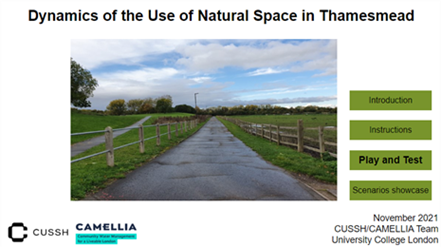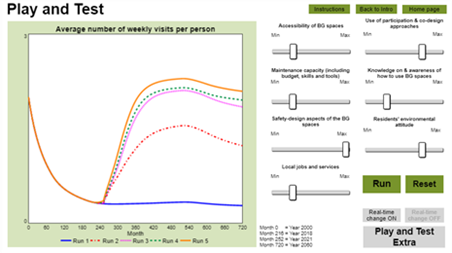
Use of Urban Natural Space (system dynamics model)
A System Dynamics (SD) model aimed at collectively designing strategies for improving people’s Use of Urban Natural Space (UoS) in Thamesmead (London, United Kingdom).
UCL Team
Author
Contact UCL Team
Email
Project website
Details
Thamesmead is a neighbourhood in South-East London currently undergoing an important urban regeneration. It is characterised by an extended network of urban natural spaces (both, blue and green) with several sites of nature conservation interest. However, our case study stakeholders underlined how these natural areas are underused.
Through a participatory SD modelling process, we created a simulation model and used it as a mechanism to build learning and co-produce novel knowledge on people’s use of natural space, whilst taking a holistic approach to investigate the factors influencing it. The simulation model captures these factors and their interdependencies: for instance, usability and accessibility, maintenance and space condition, residents' perceived safety and awareness of the spaces, community participation, biodiversity, time constraints and structural poverty. The model was applied to the co-design pilot ‘Pathways to the Thames’ managed by Peabody. Through an online accessible interface, the model allowed the stakeholders to jointly test different scenarios, exploring the impact on people’s use of space by capturing the dynamics between the influencing system elements. It was an example of true co-production of knowledge.
The model has more than 130 variables. The model structure and parameters are highly grounded on information elicited from a number of workshops/interviews with relevant stakeholders and the scientific literature. The model is calibrated based on an adjusted dataset from the MENE survey (Natural England ). The model has two different versions. The initial version focuses on the use of natural space and the factors influencing it (v1); while the second extended version adds two health sub-models (v2). In conjunction, this model uses three different indicators:
- Use of Natural Space Indicator (measured by the average number of weekly visits per person in the area under consideration; v1 and v2).
- Physical Health Indicator (measured by the relative risk of mortality; v2).
- Mental Wellbeing Indicator (measured by the relative perceived risk of stress; v2).

In the end, the model allowed for the following actions to be assessed: a) to support knowledge co-production within Peabody and knowledge-sharing between Peabody members and residents; b) to enable a conversation on levers; c) to structure, manage and unpack complexity around the topic of the use of natural space; d) to agree on priorities and ideas to bring to the co-design pilot.
Four key insights can be derived from the case study application:
- Stakeholders quickly realise that maximising the built environment components (e.g., accessibility and safety design aspects) alone does not have a major impact on improving the use of space, while strategies focusing on community interventions have larger influence.
- Scenarios focusing on the maintenance capacity show a slow increase of the use of space; although this intervention depends on a substantial increase of the maintenance budget, which stakeholders report to be difficult to achieve in practice.
- The effects can be improved when attention is paid to the local community demands (through better – fit for purpose – co-design of space) or social cohesion building and community engagement activities, showing the need for combined strategies when planning interventions.
- The model enabled stakeholders to better understand also the social-economic aspects of the use of space and discuss interventions that, for instance, would improve residents’ leisure time.
This work was co-funded by the CUSSH (Complex Urban Systems for Sustainability and Health) and by the Community Water Management for a Liveable London (CAMELLIA) projects.
Keywords:
Use of space; Natural space; System Dynamics; Health and wellbeing; Co-design; Stakeholders; Participatory modelling; System dynamics, Causal Loop diagrams, Simulation; Thamesmead; Transdisciplinarity
Links:
- Pluchinotta, I., Zhou, K., Moore, G., Salvia, G., Belesova, K., Mohajeri, N., Hale, J., Davies, M., Zimmermann, N. (2024). Co-producing knowledge on the use of urban natural space: Participatory system dynamics modelling to understand a complex urban system. Journal of Environmental Management, 353, 120110. doi: https://doi.org/10.1016/j.jenvman.2024.120110 ❐
- Zimmermann N., Pluchinotta I., Salvia G., Touchie, M., Stopps, H., Hamilton, I., Kesik, T., Dianati, K., Chen, T. (2020). Moving online: reflections from conducting system dynamics workshops in virtual settings. System Dynamics Review. https://doi.org/10.1002/sdr.1667 ❐
- Pluchinotta I., Salvia G., Zimmermann N., (2022) “The importance of eliciting stakeholders’ system boundary perceptions for problem structuring and decision-making”, European Journal of Operational Research 302(1) https://doi.org/10.1016/j.ejor.2021.12.029 ❐
- Salvia G., Pluchinotta I., Tsoulou I., Moore G., Zimmermann N., (2022). Understanding the interlinked social, spatial and temporal influences of urban green usage in London through systems thinking, Sustainability, 14 (5), 2575 https://doi.org/10.3390/su14052575 ❐
- Pluchinotta, I., Zhou, K., Zimmermann, N. (2024) Dealing with soft variables and data scarcity: lessons learnt from the quantification in a participatory System Dynamics modelling process. System Dynamics Review, 40(3) – forthcoming.